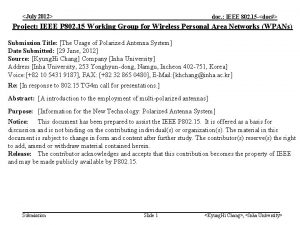July 2012 doc IEEE 802 11 120866 r





- Slides: 5

July 2012 doc. : IEEE 802. 11 -12/0866 r 0 PHY Overview Authors: Submission Date: 2012 -07 -16 Slide 1 Ron Porat, Broadcom

July 2012 doc. : IEEE 802. 11 -12/0866 r 0 Outline • Provide high level description of the PHY design for TGaf Submission Slide 2 Ron Porat, Broadcom

July 2012 doc. : IEEE 802. 11 -12/0866 r 0 Design Requirements • High ACLR – 55 d. B at the channel edge for transmission at maximum allowed power – • • Support for 3 basic channel widths – 6, 7, 8 MHz Support for contiguous and non-contiguous transmission of the basic channel unit (due to scarcity of spectrum in urban area) – • • Much higher than current 802. 11 where channel edge is at around -20 d. Br Unlike 11 ac where non-contiguous is supported only for the third largest BW Re-use 11 ac with modifications specific to TGaf Support for longer delay spread outdoor deployments Submission Slide 3 Ron Porat, Broadcom

July 2012 doc. : IEEE 802. 11 -12/0866 r 0 PHY Details • The PHY for TVWS channels is based on the 11 ac 40 MHz PHY as-is with a sampling frequency clock change, – – • Signal BW occupies about 81% (compared to 91% in 11 ac) of the TVWS channels in 6 MHz and 8 MHz regulatory domains. 7 MHz regulatory domains re-use the 6 MHz PHY – – • Sampling clock change increases symbol length and delay spread tolerance to meet 11 af requirements VHT and non-HT DUP modes are the only supported modes This enable larger guard bands to allow filter roll off to achieve -55 d. Br Same PHY design for 6 MHz and 8 MHz channels with only a sampling clock change TVWS channels are divided into an integer and even number of tones. This enables transmission and reception of multiple contiguous channels using one IFFT/FFT as in 11 ac. 144 tones were chosen to meet the desired signal BW. Submission Slide 4 Ron Porat, Broadcom

July 2012 doc. : IEEE 802. 11 -12/0866 r 0 Cont. • The PHY for multiple channels is based on the PHY for one channel. – – Submission This concept is similar to the 11 ac design of 160 MHz and 80+80 MHz whereby the tone location of DATA and pilots are the same in each case. All basic channel units (termed frequency segments in clause 23) are connect via an interleaver to maximized frequency diversity gain. Slide 5 Ron Porat, Broadcom









